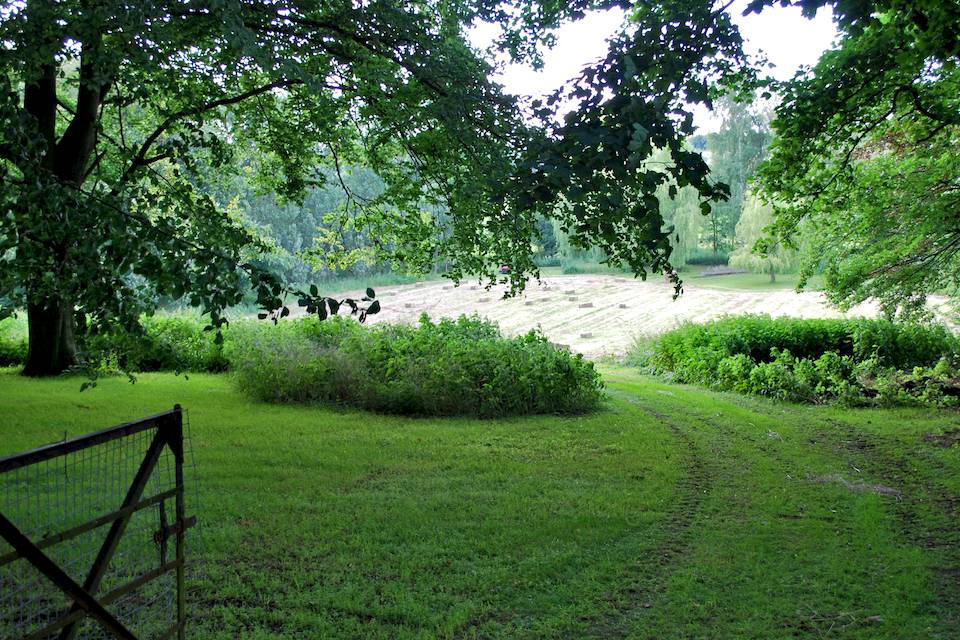Leading on from Horticultural Renaissance of Wildflowers and Wildflower Fruit & Nut Case; An interview with Sarah Raven, this post collates the experienced advice of Sarah Raven, Peter Clay, Crocus co-founder, Richard Hopkins plant manager at Applegarth nurseries, Peter Chapman owner Perryhill nurseries and Paul Barney owner Edulis, on how to actually go about creating, or as is in our case, restoring, a wildflower meadow. They all generously agreed to be submitted to countless questions on this enthralling subject, for which I am not only terribly grateful, but now also more enlightened.
‘A long term business,’ described Peter Clay, Crocus Co-Founder and proud owner of an extraordinary meadow, ‘creating a wildflower meadow, will take much time, investment and perseverance’. For the impatient gardener, such as yours truly, words such as these spell a tormenting challenge. However, the idea of wandering through the field full of native (local) wildflowers, providing oodles of luscious nectar to thronging pollinators is just too attractive a prospect to ignore. Granted, a superbly idealistic notion, the result of intensive psychological corruption by Jane Austen. However, realism should set in fairly quickly, as the future wild flower meadow, consists of a field of 2-3 acres, situated on a steep hill, running down to a stagnant river/swamp, all smothered with wild-flower-asphyxiating; couch-grass, nettles, thistles and other such nasties.
Wildflower provenance
The first step is to examine not only what is currently growing in the designated plot, but also in the surrounding area. Both Sarah Raven and Richard Hopkins, plant manager at Applegarth nurseries, strongly believe in the preservation of local wildflower genetic characteristics. Any plans for seeding or planting of wildflower varieties, should therefore coincide with the plants that naturally grow in the local habitat. Hopkins explained, ‘A plant species is not homogenous and it may well cover a huge range of habitats, and will be genetically different in different locations as it has evolved over time to survive in particular places. An article in the New Scientist described, that even when observers are unable to distinguish any apparent difference in a species in two similar habitats they had still diverged genetically’. Wildflower species will therefore be very different across counties. ‘This is important and needs to be understood for it to be maintained, as it is part of our natural heritage’, continued Hopkins. He added, ‘there is a nationally significant population of Salvia pratensis, Meadow Clary outside Chipping Norton. I have the same plant in my garden from a cultivated source and it flowers at a completely different time’.
Though scarce, the field is certainly not void of wildflowers. A dose of covert Clouseau detective work, revealed the following; Wild Angelica, Filipendula Ulmaria, Red and White Clover, Achillea Millefolium, Spearmint, (suspected) Common Bird Trefoil, Ribwort, Marsh (or Meadow) Thistle, Smooth Hawkesbeard and Meadow Cranesbill Geranium. On that basis, one can conclude that the soil in the field is naturally moist/wet. The field runs down into a valley and is hence prone to flooding. Naturally, there are variations in soil type/aspect, such as on hill, under the trees and near the hedges, but only the whole, we are dealing with thick, wet clay. Peter Clay mentioned that the variations in the fields geology will provide many different habitats for different wild flowers, making the overall result more interesting.
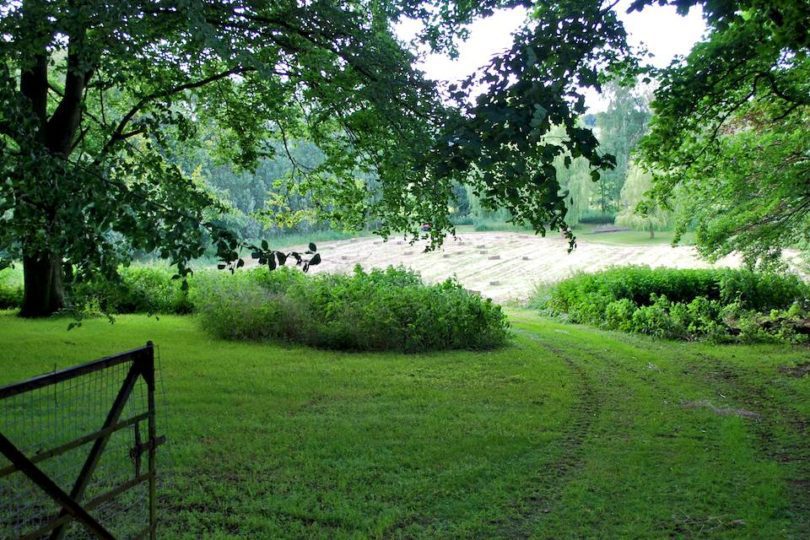

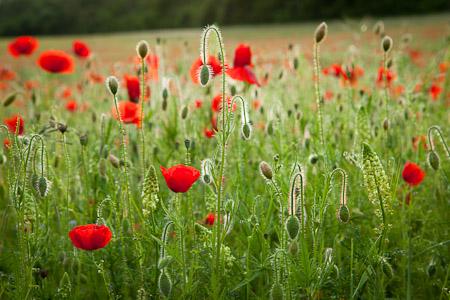
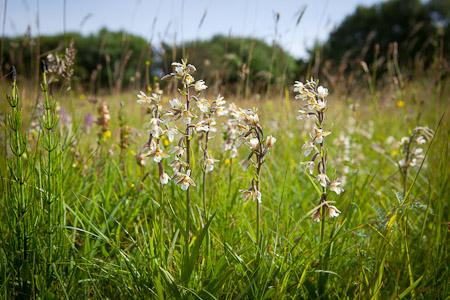
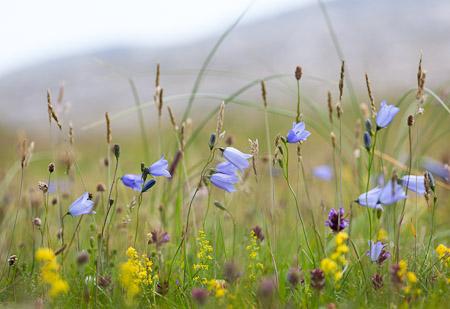
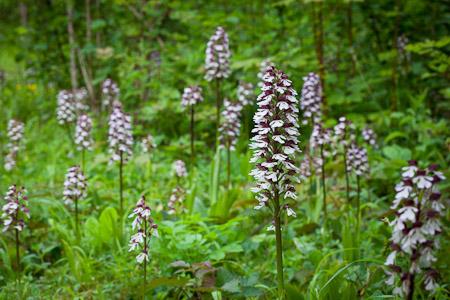
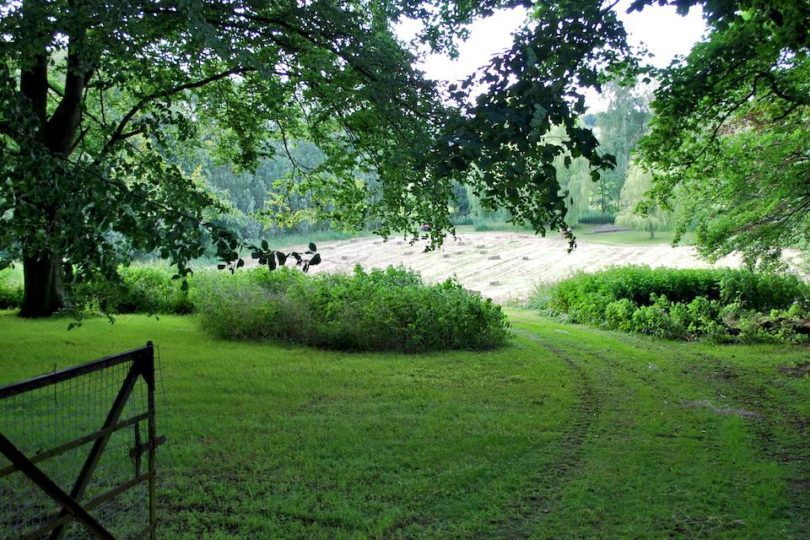
To examine the types of wild flowers growing naturally in our part of the country, Dudley (nutter dog) and I engaged in several Raven-esque ‘botanising’ trips in the countryside. Sadly the trips did not yield enormous results. We are mostly surrounded by long overworked, arable fields, planted right up to the hedgerows, and therefore have little to show in terms of wild flowers. Local expert Richard Hopkins, explained that in the past when crop rotation was still much used, these fields were abundant with wild flowers, including ‘red seas of clover’. Though as both Hopkins and Paul Barney, owner Edulis nursery explained, I may have been looking in the wrong place. Of my botanising ventures in the countryside, Hopkins said, ‘There is little point going to see wildflowers there now. You are better of going to see them along the verges, especially those on the outskirts of villages’. Interestingly, Barney explained ‘Due to the recession’s financial pressures, the local government and councils have been unable to strim their verges this year, which have therefore never looked better’. Still a sad state of affairs, that one is best to find wild flowers along road sides, rather than in the actual countryside. Thankfully, Hopkins, will be on hand to provide guidance not just on which wild flowers grow locally, but also importantly, on what used to grow here.
Soil preparation
Armed with the knowledge as to which plants will grace one’s meadow, the next step is to prepare the area for sowing and/or (plug) planting. Contrary to preparing one’s soil for luscious herbaceous borders, by incorporating loads of lovely muck to enrich the soil, the very opposite is true for wild flowers. The enemy of the wild flower meadow is enriched, fertile soil as it encourages the encroachment of grass and fast growing weeds, such as nettles and thistles. The competition between the grasses and wildflowers is too much in favour of the grasses, which as Charles Flowers confirmed in ‘Where have all the flowers gone?’; ‘wildflowers come off second best’.
There are three basic ‘nutrient stripping’, soil preparation methods;
(i) Removal topsoil
Flowers explains that growth takes place in the very top section of the soil profile. Removal of this section strips grasses and nettles of nutrients, which subsequently become less dominant, allowing delicate wildflowers and natural herbs to establish. My husband would probably disagree, but the idea of intensive JCB action in the field, is rather daunting. Unless of course, as Sarah Raven suggested, one needed topsoil desperately for the rest of the garden. Clay’s cunning plan, is to sell the removed topsoil and hence possibly provide some needed capital to fund the restoration. Unfortunately, cosmic topsoil earnings are not on the cards for us. Flowers warns against the topsoil removal technique if one’s soil type is clay. ‘Removal of precious topsoil removes all that lies between you and the clay, which is like concrete in summer and like plasticine in winter’.1
(ii) Clearing with Glyphosate
To get rid of Cooch-grass and any other persistent nasties, which will remain a problem, one could opt to clear using Glyphosate. Hence, creating a clean weed-free, seed bed to re-sow/plant with a suitable grass and wildflower mix, relative to soil type. ‘I have done this in an area at Perch Hill, where it was just thick with Cock’s-foot and Cooch grass, docks and buttercups. As it was pretty impoverished in terms of flora, it was actually best to start again and then sow a more interesting mix into it’, explained Raven. Apart from the invasive nature of chemicals, I suspect this method does not come cheap, having in the past, bought some bottles of the stuff at garden centres. Even though both topsoil removal and weed killing does have an immediate impact, the work does not end there. As the meadow king, Clay explains, ‘Don’t sow/plant immediately after clearing. Instead, allow the remaining weeds to germinate which can subsequently be sprayed off, once and for all’. He urged to mow constantly in the first year, to further reduce soil fertility as much as possible, hence weaken the grass, and allow wild flowers to become established.
(iii) Yellow Rattle Magic
Yellow Rattle (Rhinanthus minor), or Ribwort Plantain, is a parasitic plant, deriving its nutrients from the roots of other plants, especially grasses. As it strips grasses of their nutrients, they in turn are able to produce less growth and the balance of competition is changed in favour of wild flower species. As the Rattles work their magic, the plants build up in patches, feasting like vultures on host grasses. Once their hosts have ceased to be, the Rattles eventually die out, providing new bare patches which are then open for colonisation by wild flowers. According to Raven ‘Yellow Rattle will probably take two or perhaps three years to have a really definite effect, but it will have it’. She added ‘At the end of the first year, one must meticulously scarify patches, harvest your own seed and re-sow’.
Even though, immediately effective, topsoil removal and spraying are just too invasive and not practical for the scale of our field. Furthermore, be they scarce, there are wild flowers growing in the field, and the aim here is to encourage further and additional wild flower colonisation. Using Yellow Rattle therefore seems a suitable course of action. Though, there is one (small) area of the field that may see some exciting JCB action as some leveling is required. It will be interesting to see how both methods fare. Raven advised to start working with Yellow Rattle, by clearing small patches to sow seed. Though she warns ‘Don’t clear too large a patch. I made this mistake. As Yellow Rattle is parasitical on grass, by removing all the grass you remove its food supply. So you just want to do it in little patches, the size of the palm of your hand, to start little colonies. Then about a metre away do another one, and so on to then gradually will form a matrix’. For once, having a set of spirited moles is a bonus, as their little mounds offer perfectly prepared ground for the seed.
Sourcing wildflower seed
Googling wildflower seed vendors provides a multitude of possible commercial sources. Though as Hopkins and Raven both stipulated, seek local sources as much as possible. Furthermore, many areas will be running meadow conservation projects, such as Plantlife and The Grasslands Trust, that could provide seed or guide one to local sources. Naturally only with the land owners permission, Raven also advised to personally collect wild flower seed in the local area where abundantly available. For the large scale meadow, specialist companies such as Emorsgate, will be able to provide sufficient quantities of quality seed. In addition to seed, one can also opt for plug plants, which in our case will help to supplement seeding in specific areas. On the best time to seed, Raven added ‘I sowed my wildflowers in the autumn, because some of the perennials, such as Bethany, which I love, needs the winter to start germination. But it will depend on what one is sowing’. Vendor instructions of purchased seed should provide the required species specific information.
Meadow Management
An appropriate annual management regime will need to be adopted to encourage wild flowers to continue establishing and not be overrun by grasses, nettles and thistles. Cutting the meadow is crucial. Raven explains, ‘You need to cut it at least once. Because otherwise coarse growth will return, inhibiting the more interesting plants such as Orchids from getting well established. These plants would otherwise just rot down, enriching the soil again, which is the opposite of what you want to do’. According to Charles Flowers, the cutting date is vital to maintain the delicate balance of the meadow. If the meadow is cut too late, the yield of grass to wild flowers will be higher, and there is a risk of the more delicate wild flowers, being crowded out by both grass, as well as the stronger wildflowers, such as Knapweed. Flowers therefore suggests to cut the meadow late July/early August. For the well-being of native pollinators, the The Bumblebee Conservation Trust (BBCT) suggests a varied cutting regime, ‘For spring flowers such as cowslips, yellow rattle and self-heal, much loved by bumblebee queens, do not mow until late June, but afterwards mow regularly through the summer. To encourage the summer meadow flowers that will bring a swarm of bumblebee workers in July and August, cut regularly until April but then do not cut at all until September’2. For practical reasons, dictated very much by the scale of the field, and the consequent machinery (set up) required to do the cut and harvest, we will probably follow Flowers’ advice for the sole annual summer chop.
Ferdinand’s wisdom
Crucially, all the cutting material must be removed to prevent enriching of the soil, and hence maintain the delicate meadow balance. Over the past years, our field has been cut and bailed once a year by a very kind local farmer. The subsequent hay, is then destined for scrumptious cattle cuisine. Interestingly, some of the local farmers, are of the impression that the inclusion of wild flowers makes the hay unusable as animal feed. However, as the lovely Ferdinand the bull would undoubtedly testify, the very opposite is true. Flowers writes that ‘Dairymen will describe their animals going into a new field of perennial ryegrass and immediately hunting round the edges of the field to pick at the wild flowers in the hedges’3. According to Raven, ‘The theory is that wildflowers have varied mineral content that animals need on top of the grasses’. Yet to be proven, it is suspected that diseases in cattle are more common now, as cows are only fed modern rye grass and hence not getting as varied a diet as they used to. Flowers is also under the impression that cows may enjoy a slightly more enhanced menu, as wild flowers will not only have a significant impact on animal health, but also ‘on the flavour of the subsequent meal’. Naturally, there are plants such as Ragwort, which are poisonous to animals, but as Raven explains ‘In a well-maintained meadow one wouldn’t grow ragwort, and if any did come up, you would remove it’. Note to agricultural colleges out there, add Munro Leaf’s lovely book; Ferdinand to the curriculum.
I used to be of the impression that maintaining a meadow was a matter of letting nature takes its course. This could not be further from the truth. Meadows need to be managed, and that does not just include cutting. Since the creation of his own wild flower meadow in 1999, Clay explained that he experienced continued migration, uptake, decline and disappearance of species within the meadow. ‘Predictability is just not relevant to the wild flower meadow’, said Clay. Over the years, one will therefore have to work continuously to remove, supplement, and/or re-seed varieties to maintain meadow equilibrium. Seed collection/dispersal and other techniques such as hay strewing will need to be applied to ensure the continuity of the meadow and above all ensure the delicate balance of flowers to grass remains optimum. We therefore have quite some work ahead of us for years to come. Despite all that, there is no doubt in my mind, just as they so often tell us in those horrific adverts, ‘Because it’s worth it!’
Footnotes
(1) Charles Flower, Where have all the flowers gone? Papadakis, 2008, (2) Bumblebee Conservation Trust, ‘Creating a wildflower meadow’ booklet (download pdf), (3) Charles Flower, Where have all the flowers gone? Papadakis, 2008. Interviews with Sarah Raven (23/09/2011), Peter Clay (29/09/2011), Richard Hopkins (13/10/2011) and Paul Barney (03/10/2011), conducted by Petra Hoyer Millar.
